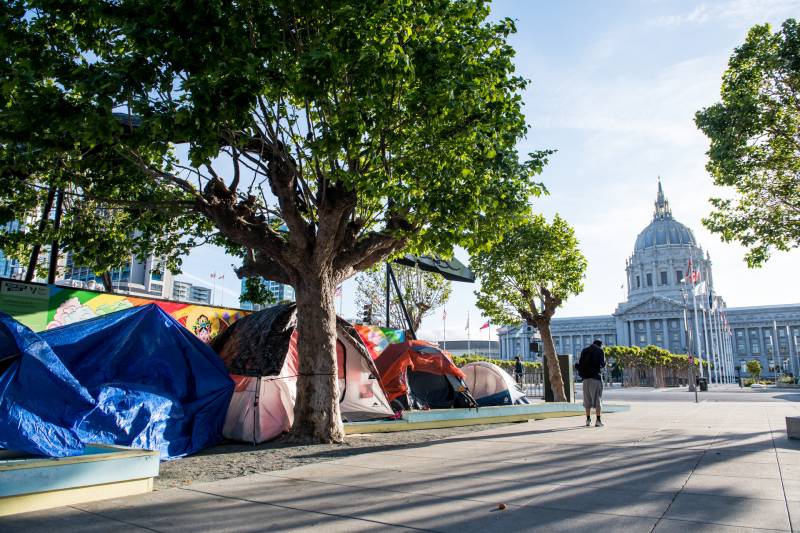This story was co-published by the San Francisco Public Press, a local nonprofit public-interest news organization, and ProPublica, a Pulitzer Prize-winning investigative newsroom. Sign up for the Public Press’ newsletter and ProPublica’s Dispatches to get stories like this one as soon as they are published.
A
t a bustling makeshift flea market on a street corner in San Francisco’s Mission District, Ladybird sells her wares. One afternoon in December, wearing a black hoodie, faded black jeans embroidered with roses and carefully applied makeup, she biked three blocks from the city-sanctioned tent encampment where she lives, carrying a bag with a still-sealed Minnie Mouse stationery kit and a brand-new pair of brown high heels. Almost immediately, she was approached by a man interested in buying the stationery kit to give to his daughter for Christmas. “Eight dollars,” she said. He talked her down to five, and a deal was made.
During a pause in bartering, a text message appeared on her phone. “I’ve been assigned a case manager! It happened this morning,” she exclaimed, calling over her friend Johnny to tell him the news. “I’m going to be moving indoors in the next couple weeks.”
Ladybird said she hasn’t lived indoors in seven years. This winter, she said, she finally got approved for a permanent supportive housing unit — a subsidized room with health, employment and social services, paid for by the city and federal government. But despite her optimism, that didn’t mean the end of her wait. In San Francisco, the path from homelessness to housing can take as long as two years, and that’s for someone lucky enough to make it onto the waitlist.
San Francisco’s struggle with housing its unhoused population is notorious across the nation. Multiple mayors have promised to get the crisis under control. The city’s dedicated homelessness department, created in 2016, has an annual budget of $598 million — a sum that has more than tripled in its short existence.
Nonetheless, as of early February, the city’s Department of Homelessness and Supportive Housing reported 1,633 homeless people like Ladybird — approved for housing and awaiting their turn to move in. Yet records provided by the department show 888 vacancies in its permanent supportive housing stock as of Feb. 22. Filling those empty rooms would not just cut the waiting list by more than half. It would be enough to house roughly 1 in 8 eight homeless people in the city. The homelessness department said it cannot talk about individual cases, but officials acknowledged that at least 400 people have been waiting more than a year, far beyond the department’s professed goal of placing applicants into housing 30 to 45 days after they’re approved.
These persistent vacancy numbers stem largely from two new bureaucratic problems. First, the homelessness department created a policy that bumped hundreds of people who had previously been approved for housing to the bottom of a new list. In December 2020, the department rolled out a plan that reserved all available permanent supportive housing units for residents of shelter-in-place hotels, which had been opened during the pandemic to keep people who had been living on the streets safe from COVID-19.
This led to a spike in vacancies as many hotel-dwellers opted to stay in place rather than accept a more permanent option. It also meant that everyone else — people on the streets, in shelters, in navigation centers and in city-sanctioned tent sites — was out of luck, simply based on where they slept at night.
It’s into this void that Ladybird fell. A resident of a tent site, she was behind an even larger number of people on an already-massive list.
Second, even when someone is approved to move in, the city is slow to send the paperwork — what’s called a “referral” — over to the private nonprofit organizations contracted by the city to manage housing units. Over the course of the pandemic, this problem has grown steadily worse.

